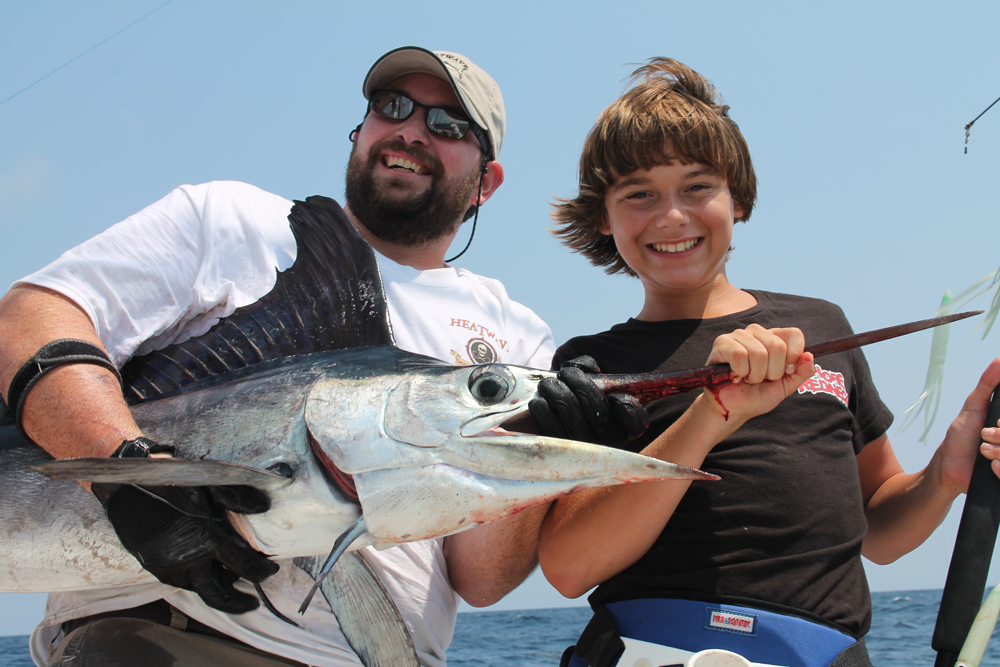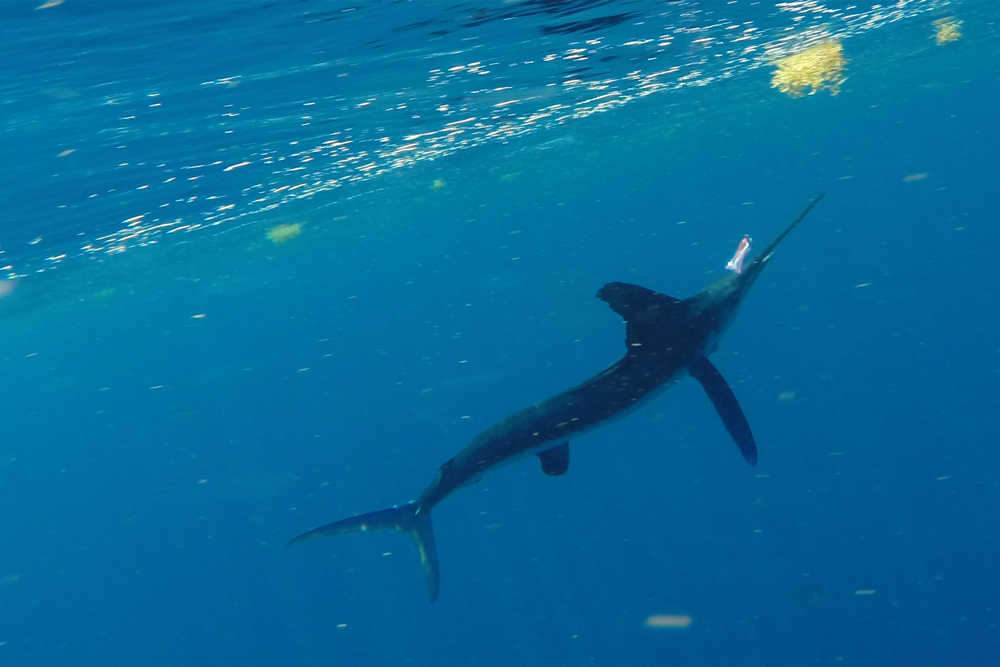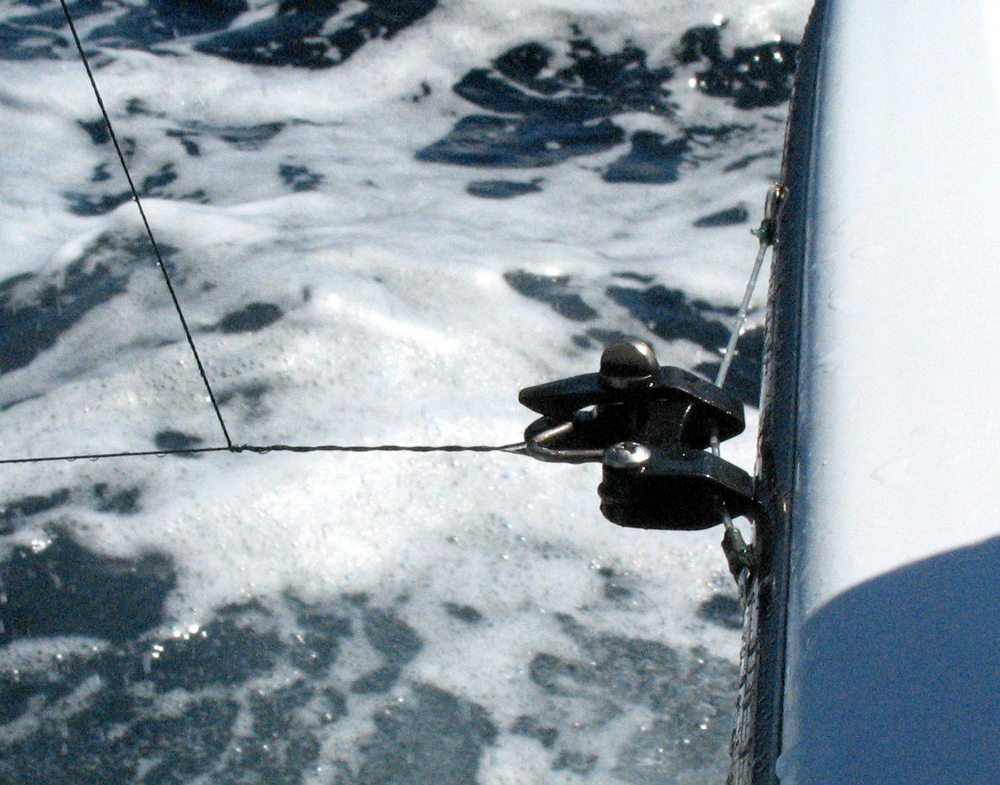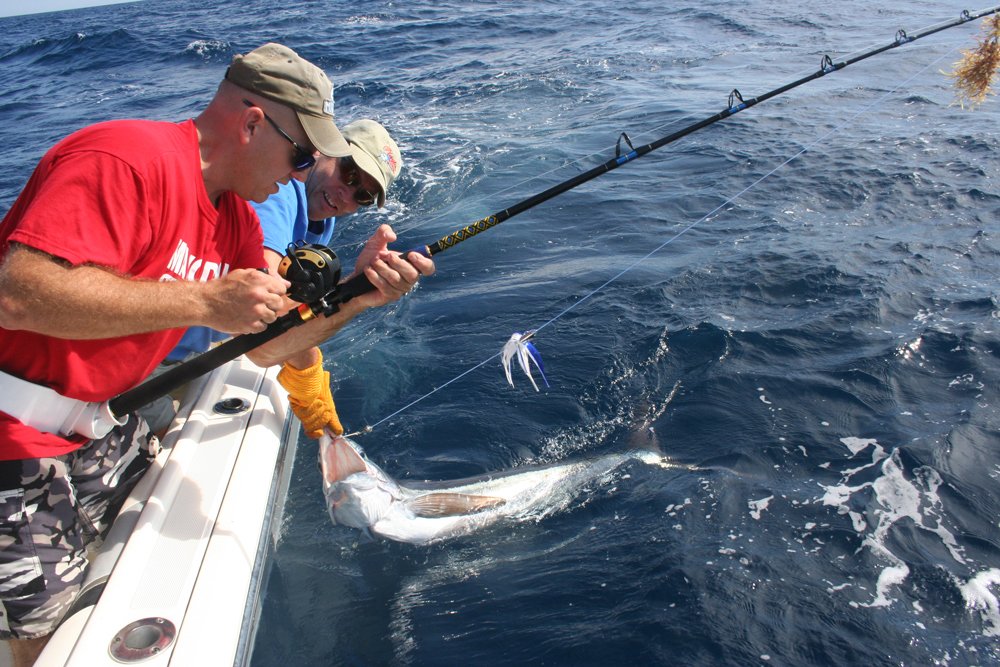In Billfish Special Part I: Fishing and Baiting Marlin we examined factors like how to locate an appropriate area to troll for billfish, and how to troll for them. But once a marlin is in the spread, getting it onto a hook is a completely different topic. If your idea of an offshore day of billfishing includes sitting on the bridge with your feet propped up, taking naps and in general enjoying a relaxing day on the ocean with your buddies, target something else instead. Billfishing requires 100-percent attention if success is to be achieved consistently. Sure, anglers occasionally catch a billfish that commits suicide, but rest assured this is not the norm. Marlin fishing is hands on, requiring anglers to bait and hook the fish. Watching the spread and observing a billfish before it attacks greatly increases your hookup percentage.

Hooking Marlin
When a fish is observed behind a rigged bait, take the rod in hand, place the reel in freespool, hold the bait in position with light thumb pressure on the spool, and turn the clicker off. If the clicker is left on, as the fish spools line the clicker’s vibration and noise is transmitted through the taut line, which can be the culprit that causes dropped baits. Speaking of vibration and noise, when a billfish rises to a bait try to keep noise to a minimum. It’s difficult not to yell, jump and bang around the pit when a bite occurs. However, all that sound transmits through the water. Hydrophone testing reveals cockpit noise overshadows engine and propeller sound underwater. Anglers are often heard referring to billfish raised but not hooked as “window shopping,” which is a fish that rises to a bait only to swim away without attacking. It is possible many of these fish are frightened by all that cockpit noise.
It’s important to feel the bite before freespooling. The art of freespooling allows fishing line to fall from the end of the rod tip once the bait is picked up by a marlin, without the fish feeling any resistance. When ready to freespool, point the rod at the fish while keeping only the slightest thumb pressure on the spool. Apply too much pressure, and when the fish grabs the bait it may be ripped off the hook or pulled out of the fish’s mouth; pressure must be kept to an absolute minimum, only enough to prevent backlash. Do not increase thumb pressure when the bite is felt.

Line being freespooled leaves the reel at a steady rate from the boat’s forward progress and when the spool speeds up or becomes erratic, it indicates that the fish is swimming off and swallowing the bait. Count to five and slowly advance the drag lever, while the rod remains pointed at the fish. It is important to slowly advance the drag. This assures the circle hook is not snatched out of the mouth, and sets it securely in the corner of the fish’s mouth. Once the weight of the fish is felt, slowly raise the rod tip, and begin the battle. When the bite occurs, the rest of the crew’s job is to keep all eyes on the spread looking for additional billfish – not watching the angler or high-fiving.
Bait and Switch
There is no greater thrill then using the bait-and-switch tactic to hook a billfish, which is performed when a fish is spotted on a teaser. But it takes teamwork and practice, then more practice, to pull off the manuever. The coordination of two anglers is required, one to handle the teaser and the other to handle the rod. The teaser is retrieved at a steady rate of speed with the billfish chasing, while an angler simultaneously freespools a pitch bait in line with the teaser. The rod is pointed towards the fish with the reel in freespool, clicker off and only enough thumb pressure to stop line from backlashing. As the teaser is wound by the pitch bait, it’s snatched away – and the billfish’s attention switches to the rigged bait. The time from the marlin attacking the teaser to switching over to the bait is only a matter of seconds.
It's imperative that the pitch bait swim correctly when it hits the water. A spinning bait ruins the opportunity and leaves anglers with only thoughts of what could have been, so the pitch bait should be tested before actual use. Where to store a pitch bait can present a problem. The rod and bait need to be in the pit and ready for action at an arm’s reach, at all times. Many anglers dedicate a small cooler at the transom to hold the bait. Others install a bait tube. For a couple bucks you can construct a pitch bait holder with a piece of two-inch PVC capped off at one end. Screw on a couple suction cups, fill it with sea water, and you’re ready to keep a pitch bait prepped for action. Regardless of what system you come up with, the pitch bait must be immediately accessible when a marlin rises to a teaser.

Another option for boats with limited space is to utilize a flat line already in the water for the bait and switch. This works well, however, it removes one of your baits which could otherwise hook up a second fish.
Mystery Bites
A certain form of Murphy’s Law applies when billfishing. It states, “billfish appear where you are not looking.” But you can often turn mystery bites into hook-ups. When a rod is hit and missed, don’t just shout “he missed it.” When the snap of a rigger or flatline clip grabs your attention but no hook-up follows, immediately place the reel in freespool as the rod is taken in hand, or even before being removed from the rod holder. The marlin has likely wacked the bait with its bill and expects it to be stunned – which you can simulate, if you can go into freespool quickly enough. If the bait is not picked up in a couple seconds while freespooling, stop and raise the rod tip high overhead to get the bait back up on the surface, then jig and/or crank the rod to put action into the bait, as if it’s trying to escape. This often creates a second opportunity.
Finicky billfish often grab a flat line bait, snap the clip, and swim away only to drop the bait. This is probably due to the resistance being felt, before the angler can get to the rod and freespool. To solve this problem and reduce drag resistance, twist the fishing line before inserting it in the flat line clip. The friction caused by the twisted line holds it in place, allowing you to set the reel’s drag at a minimum resistance, with only enough pressure to prevent a backlash. Then set the flat line clips at the lightest setting possible where they won’t trip from wave action.
Multiple Marlin Hook-ups
Multiple hookups do not just happen, they are created. After the first fish is hooked up, the captain turns the boat towards the side the fish is running. The angler must keep all slack out of the line during this maneuver. I want to emphasize again, everyone’s eyes need to be watching the remaining baits, not the angler fighting the marlin.
Burning a hole accounts for the stories of multiple hookups and those hard to believe releases of 15 or 20 billfish in a day. It’s certainly to a crew’s advantage for everyone to be well versed and capable of performing every task in the pit when multiple hookups occur and orders are being given. Going over a plan of action on the ride out to the canyons is well worth the time to prepare for later when opportunity knocks.
Artificial Lures
Setting the hook with a lure is quite different then rigged bait. When a marlin follows a lure, raise the rod tip slightly and pull the lure away, so the fish chases and attacks just as it does a teaser. When the fish opens its mouth lower the rod tip, actually placing the lure in the mouth. When pressure is felt, set the hook. It’s important not to give the fish time to spit the lure. The setting of the hook is immediate upon feeling pressure.
Many anglers prefer several hard, short jerks to embed the hook in hard jaw area. If the fish misses the hook, a quick jerk or two often brings it back on the lure.
If a lot of ground needs to be covered when searching out billfish, high-speed trolling with lures may be preferred to an all-bait spread. This is typical when targeting blue marlin. Trolling at eight to 10 knots allows a lot of territory to be fished.

It’s important to keep an artificial lure moving when a blue marlin rises, becomes aggressive, and bats the lure around. The flat line or rigger clips should not release while a marlin is playing with its meal. Set clips on the tight side; eight to 10 pounds of clip pressure assures a good hookup. However, use caution when tightening outrigger clips, as they can actually snap riggers if they don’t release. To make this a simple matter, tighten the clips down and use a #32 rubber band for attaching the line to the clip. This provides around a nine-pound breaking point.
Be patient when a marlin becomes aggressive and attacks a lure. Pick the rod up and wait for the rubber band to break. The reel drag should be set on a strike setting of around 10 pounds. When the rubber band breaks, the fish should be hooked. As the first run is made, slowly push the drag up and settle in for your butt-whooping.
Most billfish caught by recreational anglers occur when a mixed spread is pulled for a variety of pelagics during a day spent offshore, as we discussed in part one of our Offshore Trolling series. However, by using tactics targeted directly for billfish, the chances are greatly improved for anglers who desire the ultimate offshore experience.
- By John Unkart. For additional billfish tips and techniques check out author’s books, “Offshore Pursuit” and “Saltwater Tales.”